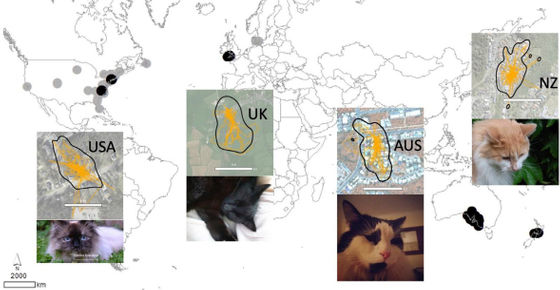30 billion wild animals are killed by outside cats annually in North America alone, experts say `` cats are kept indoors ''

by
Studies published in 2019 show that Australian cats are pushing rare wildlife to extinction . The newly announced large-scale experiment with nearly 1000 cats equipped with GPS devices has revealed that cats are a threat to wildlife around the world. For this reason, researchers recommend 'keep cats indoors.'
The small home ranges and large local ecological impacts of pet cats
(PDF file) https://drive.google.com/file/d/1HZ0wmjhQEIK361kLc7eGZTFKuorteIOZ
Keeping Cats Indoors Could Blunt Adverse Effects to Wildlife | NC State News
https://news.ncsu.edu/2020/03/domestic-cat-effects/
Should you let your cat go outside? GPS study reveals the deadly consequences
https://www.inverse.com/science/should-you-let-your-cat-go-outside-gps-study-reveals-deadly-consequences
Cats have a 'catastrophic impact' on local wildlife when allowed to roam free | Daily Mail Online
https://www.dailymail.co.uk/sciencetech/article-8100023/Cats-catastrophic-impact-local-wildlife-allowed-roam-free.html
Research teams at North Carolina State University and the North Carolina Museum of Natural Science have installed GPS devices on a total of 925 domestic cats living in six countries, including the United States, the United Kingdom, Australia, and New Zealand, and have studied the cat's range of activity. The results showed that most cats were operating within a 100-meter radius of their homes.
The following is an example of tracking results with GPS, an American domestic cat `` Cutnis Eva Dean '' which is a very narrow example with a range of 1.6 ha from the left, a British `` Wharf '' which is a wide example with a range of 16.2 ha from the left The average range is 4.3ha and 3.3ha, respectively, Australia's 'Bugsy' and New Zealand's 'Theo'. In general, young cats and cats living in the countryside tended to have a wide range of activities.

In addition, as a result of compiling reports from the owner, it was found that cats average 3.5 prey, such as rats, per month. Assuming that cats do not necessarily return with their prey, the research team estimated the `` ecological effects of cats on wildlife '' in terms of rats from the number of prey and the cat's range of action, The result is that the effect of one cat as a pet on wildlife during the year is 14.2 to 38.9 rats per hectare.

Given that the impact of a wild predator weighing 5 kg is equivalent to 16.9 animals and that a
'We have found that cats can affect wildlife 2 to 10 times more than wild predators of the same size,' said Roland Kays, a zoologist at the North Carolina Museum of Natural Sciences. I do. '
In total, cats kill only about 50 animals a year compared to jungle cats that hunt more than 4,000 rats a year, so it seems that this is not much of an effect compared to wild predators. However, cats have a narrower range of action than normal wild predators, so the impact on wild animals living in that range is very large.

`` Domestic cats eat cat food, so they have less prey than wild predators, but their range of action is so small, 'said Kays. Are concentrated in a small area, and because domestic cats live close together with humans in specific areas, their effects on the ecosystem are amplified, affecting birds and small animals. The impact will be significant. '
'It is estimated that cats kill between 10 and 30 billion wild animals annually in North America alone. The easiest solution to this problem is to' keep cats out of the house. ' And comments. In addition, co-author Rob Dan said, `` Human desires that the natural environment is full of various creatures, but by putting cats out of the field, it makes it difficult to realize that hopelessly 'And emphasized the effects of keeping cats out of the house.

Related Posts:







